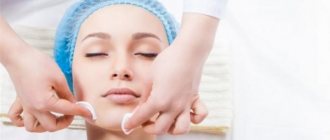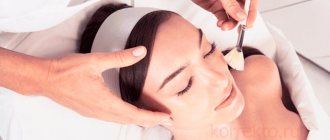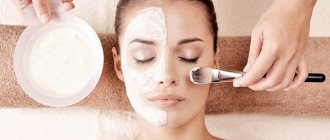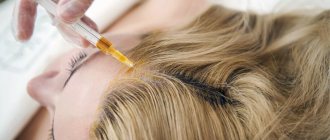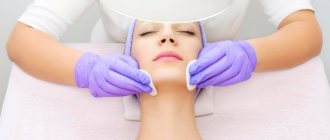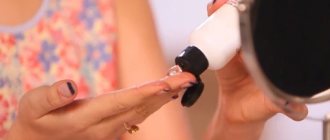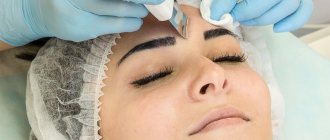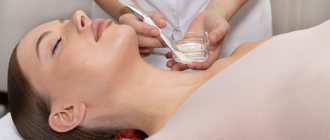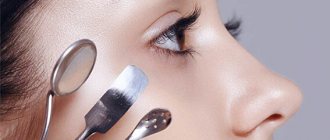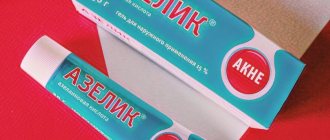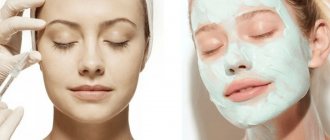Cleansing procedures for the skin have always aroused the greatest interest among patients in cosmetology clinics. A healthy epidermis is an important component of an attractive appearance. The variety of cleansing effects offered in salons does not always allow you to make an error-free choice. A cosmetologist will help you decide, but it won’t hurt to know general information about possible interventions in advance. To keep the epidermis clean, it is recommended to pay attention to peeling or facial cleansing. What is better to prefer or how to correctly combine procedures, we will figure it out further.
Peeling: features of impact
Peeling is an ideal mass choice for thoroughly cleansing the skin. The procedure allows you to remove dirt from the pores and exfoliate the keratinized layer of tissue. The impact activates local metabolism and stimulates the renewal of integument.
To achieve the goal, different exfoliation options are used. Superficial chemical peels are widely popular. The method is available for home use, simple, comfortable, and does not involve complex rehabilitation. At the same time, light exfoliation with acids provides an optimal cleansing effect.
Note! Ultrasonic peeling is also of interest, the results of which combine the effect of exfoliation and pore sanitization. You can buy an ultrasound device for home use. The aesthetic ultrasound procedure is simple and effective.
Superficial peeling is indicated for sanitation, healing of the integument, and prevention of age-related changes. The intervention allows you to achieve:
- cleansing the skin surface of dead cells;
- opening, narrowing pores;
- elimination of comedones, acne;
- normalization of the sebaceous glands;
- reducing the tendency to rashes;
- increasing turgor, improving the appearance of the epidermis;
- minimizing pigment spots, scars, wrinkles.
As a result of the procedure, the overall functioning of tissues improves. This is useful for everyone, with the exception of those with contraindications that are predominantly temporary.
Often, superficial acid peeling precedes other procedures. These include: plastic surgery, injection treatments, banal cleaning. https://youtu.be/https://www.youtube.com/watch?v=p4PM_I5Es_A
What is the difference?
In order to determine the differences between the two cosmetic procedures, let’s consider the essence of each process:
- Peeling is a session of deep cleansing of the epidermis, during which the upper dead layer of cells is removed. After its removal, the mechanism of enhanced natural restoration of the skin is launched.
- Cleansing is a hygienic procedure during which the skin is cleansed of acne, sebaceous plugs and blackheads. After cleansing, the epidermis begins intensive renewal.
Distinctive features of peeling:
- Experts recommend peeling if the skin has wrinkles, age spots, has lost its elasticity and has become dull.
- Can be used on any skin type.
- The procedure is prescribed for persons over 25 years of age.
Distinctive features of cleaning:
- Relevant for people with sebaceous plugs, blackheads and comedones on the face.
- First of all, it is recommended for those with oily and problematic skin.
- The procedure can be carried out from adolescence, when skin problems appear against the background of hormonal changes in the body.
Types of cleansing performed by a professional cosmetologist
There are several types of professional facial cleansing that can be performed by a cosmetologist:
- Mechanical . The easiest way to cleanse. It involves manually removing unwanted elements from the skin. The cosmetologist can carry out the procedure with his hands or use special cosmetology tools: a Uno spoon, a brush, a Vidal needle, a loop. During the session, damage to the skin is possible.
- Vacuum. For cleaning, a special vacuum device is used, which operates on the principle of a vacuum cleaner.
Before the procedure, the face must be steamed.
The device pulls out dirt and sebaceous plugs from the pores, and also removes dead cells.
- Ultrasonic . It is carried out using a special device - a scrubber. The opening of pores, their cleaning and removal of the upper layer of the epidermis occurs under the influence of ultrasound. Ultrasonic cleaning is painless and takes little time.
- Galvanic . Purification occurs under the influence of electric current from a galvanic device. Under its influence, the pores expand and their contents are destroyed. Before the procedure, a special gel is applied to the face, which conducts current and ensures better glide of the device, and also interacts with the contents of the pores. The procedure is painless and does not damage the skin.
Vacuum, ultrasonic and galvanic cleaning are hardware cleaning methods. During hardware procedures, only the upper layer of the epidermis is affected.
More information about the types of cleaning is described in this video:
Types of peeling procedure
Peeling can be classified according to the methods of exposure:
- Mechanical . It is carried out using abrasive particles that are applied to the skin and remove dead epithelium under pressure. Mechanical peelings include brossage - peeling with brushes, scrub and gommage.
- Chemical . It is performed under the influence of active chemical components and special compounds. For example, phytic acid.
- Acidic . The procedure uses lactic, mandelic or glycolic acids.
- Enzymatic . With the help of plant enzymes, blood flow is stimulated and epidermal cells are renewed. Use enzymes from pomegranate, blueberry or pineapple.
- Physical . Dead cells are burned with dry ice or removed with a laser.
Based on the depth of impact, peeling is divided into three categories:
- Superficial . It affects only the upper layer of the epidermis, where there are no living cells. Fruit acids are used for superficial peeling. It is suitable for young skin.
- Middle . Removal of dead epithelium occurs using a hardware method and special means. After peeling, a recovery procedure follows.
- Deep. Completely removes old skin, without affecting only the growth zone - a thin layer of cells from which epidermal tissue will be restored. It is used for serious age-related changes, the presence of deep wrinkles or scar tissue. The procedure is painful and is performed using anesthesia.
For deep peeling, formulations containing the toxic substance phenol are used, so deep peeling can only be carried out by a highly qualified cosmetologist.
You will learn more information about different types of peeling from this video:
Difference between application methods
The cleaning procedure is divided into several stages:
- Preparatory stage : Cleansing the face of cosmetics.
- Removing the upper stratum corneum using a scrub or gommage.
- Steaming the skin.
- Treatment with a disinfectant solution containing alcohol.
- Applying a mask that will soothe the skin, tighten pores and heal damage.
Chemical peeling procedure:
- Cleansing the face of makeup.
- Degreasing the skin.
- Application of acid solution.
- Neutralization of acid using an alkaline solution.
- Washing your face.
- Treatment with a disinfectant solution.
- Application of a protective agent.
Advantages and disadvantages
Let's look at the pros and cons of each cosmetic procedure. Benefits of peeling :
- Pigmentation is lightened.
- Wrinkles are smoothed out.
- The color and texture of the face is evened out.
- The youthfulness of the skin is prolonged.
Flaws:
- Chemical peeling makes the skin thin and sensitive to UV radiation. Therefore, the procedure is carried out during the period of minimal sun activity: November - March. After a peeling session, it is necessary to use creams that protect against UV radiation.
- The cost is 2 times more expensive than cleaning.
- Medium and deep peels have a long recovery period of up to several weeks.
- After peeling, scarring, increased skin sensitivity, redness and peeling may occur.
Pros of cleaning:
- The skin gets rid of imperfections, blackheads and comedones.
- The oiliness of the skin is reduced and its texture is evened out.
- Improves complexion.
- There is no long-term recovery after hardware cleaning.
- Doesn't take much time.
- Affordable.
Cons of Cleaning:
- Recovery after mechanical cleaning occurs within several days.
- The procedure must be done systematically, especially for people with problem skin.
- Painful sensations are possible, especially during a manual session.
- Redness of the skin after the procedure.
Facial cleansing: characteristics of the procedure
Facial cleansing is an ideal option for thorough cleansing for those with oily, combination skin and a tendency to regularly clog pores. The procedure allows you to achieve complete cleansing of the ducts, removal of sebaceous plugs, blackheads, comedones, and pimples. The impact is aimed at hygiene, restoration of impaired tissue functioning.
To achieve the goal, laser, ultrasound, vacuum, brushes, and special preparations are used, but the most common option is mechanical cleaning, performed by hand, using tools. The cleansing method is simple and in demand at all times. It is proper cleaning that allows you to completely get rid of the contents of the pores.
Periodic facial cleansing is recommended as a thorough hygiene procedure for anyone who is prone to clogged pores and the appearance of rashes. The intervention allows you to achieve:
- freeing pores from impurities;
- removal of blackheads, comedones, pimples;
- improving the health and appearance of the epidermis;
- improving the functioning of tissues.
Deep cleansing of skin pores is aimed at solving a limited range of problems. The procedure is necessary as a regular intervention for a certain group of patients.
Exposure is mandatory before any intensive care program. Patients with moderate clogged pores and no inflammation are offered to make do with the use of cosmetics with strong cleansing abilities. Those with an unattractive picture on their face will not be able to eliminate mechanical effects.
Types of cleanings
This form of skin treatment can be:
- manual, when the cosmetologist mainly works with his hands;
- hardware, requiring additional use of special equipment;
- ultrasonic, carried out using a vibrating device;
- galvanic, based on the use of an alkaline solution and electric current.
Despite the variety of modern devices, the manual method remains the most effective. If necessary, it is combined with ultrasonic cleaning or other methods of influencing the skin.
Similarities and differences between procedures
Both cleansing options, peeling and cleansing, are aimed at maintaining skin hygiene, sanitizing and improving the health of the integument. At the same time, exfoliation is aimed at achieving brighter, more comprehensive results.
Cleaning, on the contrary, gives a narrowly targeted effect: deep cleansing of pores. This is a significant difference between one option of deep cleansing and another.
Peeling is suitable for a wide range of patients. The intervention can be performed for the prevention and treatment of deficiencies. Cleaning is done strictly according to indications.
The process is aimed at eliminating problems. Preventing the formation of aesthetic defects using pore-scanning interventions is difficult. This is a significant difference between the options.
Peeling and cleaning are approximately the same in terms of the comfort of the process, the possibility of developing side effects and complications. There are a wider range of contraindications for exfoliation. Cleaning is often performed on young patients, and peeling on mature patients. The cosmetologist will tell you how one treatment option differs from another if you have doubts about the choice.
In what cases is peeling done?
Peeling can have an undesirable effect on the protective reserves of undeveloped youthful skin, so it is recommended for patients over 25 years of age. To select a specific treatment option, you need to take into account the characteristics of the epidermis. The following are the types intended for specific skin types:
- normal – with fruit acids;
- combined – retinoic, Jessner peeling;
- oily – preparations containing hyaluron;
- dry – milky, ultrasonic.
Peeling compositions are not used for pathologies such as diabetes, heart and vascular diseases, and cancer. The procedure is not performed in childhood, during pregnancy and gestation, as well as in cases where not enough time has passed since the previous one.
What to choose
A cosmetologist will help you make a choice in favor of cleaning or peeling. The procedures often complement each other. It is impossible to put an equal sign between them. The influences are aimed at obtaining different results. The effect of the procedures is compatible, but not comparable.
A cosmetologist can give a clear answer to the question of choice. The doctor will assess the skin condition and select a care program. Often the cosmetologist's response is to convince him of the need to perform two procedures sequentially.
If we talk about the primary need for this type of intervention, then cleansing is prescribed for those with oily, combination skin with acne and pimples. Peeling is mandatory for hyperkeratosis, the presence of age spots, scars, wrinkles, and decreased tissue turgor.
Which is better: ultrasonic cleansing or chemical peeling?
Only an experienced cosmetologist can correctly answer the question of which is better - peeling or ultrasonic cleaning. He will assess the condition of the skin, its features and make recommendations, including based on the patient’s age.
If we compare both procedures without reference to a specific patient, then ultrasonic cleaning looks preferable. It is painless, does not require much time, is safe for the epidermis, and there is no need to restore the skin after it. You can get burned during a chemical peel, and a recovery period is required after any type of peeling procedure .
Combination rules
Many patients are interested in whether it is possible to do both cleansing options at once. According to ordinary people, this will bring a double positive effect.
Cosmetologists do not recommend performing both procedures at the same time. The best option: preliminary preparation of the skin using cosmetics with a slight exfoliation effect. It is acceptable to exfoliate using products with minimal acid content, right before cleansing.
Perform standard professional peeling (acid concentration 20–50%) with any depth of impact, it is recommended at intervals of 1–4 weeks before or after cleansing. More precisely, the gap interval will be determined by a cosmetologist.
Attention! There is an option to “close” the cleaning with peeling. Cosmetologists use light acid preparations. Exfoliation is not done if the integrity of the tissue is damaged. Mechanical cleansing of pores is not performed if the stratum corneum is excessively thick and covers the ducts.
The doctor can prescribe the sequence of procedures. If the pores are excessively clogged, it is recommended to first clean them, after healing, and if there is no inflammation, peel them. If the skin is excessively thickened and dehydrated, then it is better to initially choose peeling.
Be careful: medical contraindications
If the decision is made, carefully read the following list of medical contraindications.
Cleaning should not be carried out under any circumstances:
- In the presence of fungal, inflammatory, viral and infectious diseases on the face, unless they are cured before starting the procedure;
- If there are severe diseases of internal organs and any neoplasms (this also applies to peeling);
- If you have rosacea, trichosis, herpes and cheilitis;
- With increased fragility of blood vessels.
- If you have temporary health problems. You can learn about peeling with calcium chloride in this article.
Peeling is contraindicated in the following cases:
- During pregnancy and breastfeeding;
- For viral diseases accompanied by high temperature, in particular fever;
- For pustular diseases on the skin and herpes;
- For any cancer;
- .For serious diseases of the cardiovascular system;
- For allergic diseases or allergies to certain substances.
Opinion of cosmetologists
Doctors approve of both cleansing options: peeling and cleansing. Procedures are prescribed or their sequential implementation depending on the needs of the patient’s skin. Exfoliation and mechanical cleansing of pores are avoided only if there are contraindications.
The cosmetologist recommends monthly cleaning and seasonal peeling.
The cosmetologist recommends light peeling followed by cleansing.
The cosmetologist allows cleaning and peeling with the right approach to the patient.
The cosmetologist sees harm in cleaning for those with rosacea.
Is it possible to combine?
Peeling and cleansing have different effects on the skin, and experts say that these procedures can be combined. They will not only complement each other, but will also allow you to achieve maximum efficiency.
Before combining procedures, it is recommended to consult with a qualified cosmetologist who will tell you the order of their implementation. Both cosmetic procedures, despite their differences, can heal and cleanse the skin, making it younger and fresher. To choose the best method for yourself, do not forget to consult a specialist.
Patient reviews
Patients have a positive attitude towards exfoliation. Many people choose this method of deep skin cleansing. Opinions about mechanical sanitation of pores are often negative. Patients see the procedure as a temporary solution to the problem, but at the risk of worsening the situation.
Opt for peeling.
The patient does not approve of regular cleanings and advises establishing daily care.
Is it possible to do it at the same time?
Cleansing during the application of both procedures is carried out in different directions, however, when using them simultaneously, it is important to first consult a cosmetologist.
With each exfoliation session, the skin is exposed to additional negative effects. When procedures are carried out immediately one after another, more severe trauma occurs to the layers of the epidermis, which can significantly increase recovery time.
When cleansing the skin of the face, such actions are undesirable, since they will not only not give the expected result, but will also start the process of premature aging.
Facial skin care treatments are an excellent method to get rid of many skin problems. Only a specialist can advise what to choose, based on the type of skin, its characteristics and existing problems. It is important to remember that it is not recommended to carry out procedures one after another at once. The decision on such actions should also be made only by a cosmetologist.
The essence of the method.
Patients of our center have been familiar with the carbon peeling procedure for a long time. In our practice, we have been successfully using this procedure for many years to correct many cosmetic problems. Although this method has become widespread relatively recently. Carbon peeling method with a high cleansing, rejuvenating and healing effect has gained popularity in a short time and is widely used to improve the quality of the skin and appearance of our patients.
Peeling is called so due to the main component of the nanogel used during the procedure. Nanogel contains a large amount of carbon dioxide, and carbon in translation is carbon. This is the main secret of the effectiveness of the procedure and its distinctive feature from conventional laser therapy.
The secret to the effectiveness of peeling is the simultaneous exposure of the laser beam and gel components, which are delivered to the deep layers of the skin. Carbon nanogel is applied to the surface of the skin before peeling. When the gel is partially absorbed, it is exposed to a laser beam.
Thus, the nanogel is a kind of amplifier of laser action. Thanks to it, when a laser beam passes, an “explosion” of the carbon gel occurs, located both on the surface of the skin and in the sebaceous glands. Particles of sebum and dirt embedded deep in the pores are removed along with dead cells.
This leads to a narrowing of the excretory ducts of the sebaceous glands and, as a result, a decrease in skin oiliness and narrowing of pores. In addition, the laser beam “sterilizes” the treated skin surface and has an anti-inflammatory effect, which leads to a decrease in pathogenic microflora parasitizing in the deep layers of the dermis and on the surface of the skin.
The neodymium beam provides powerful heating of tissues, penetrating to a depth of 0.5 mm. An increase in temperature in the inner layers accelerates metabolic and regeneration processes, improves cell function, causes accelerated synthesis of natural collagen and elastin, activates fiber renewal and, as a result, skin rejuvenation.
The main differences between cleansing and peeling
| Comparison Questions | Cleaning | Peeling |
| The essence and main mechanism of the procedure | Cleaning is a list of actions aimed at removing dirt and secretions from the pores with your fingers or using tools. Requires preliminary steaming of the skin. | From English “peel” - remove the peel, peel. During the process, the dead layer of skin is deliberately injured, provoking the division of normal cells, followed by measures to restore skin tissue. |
| Indications | Porous or aging skin, oily shine. Blackheads, acne, low skin tone. | Pigment spots, wrinkles, low turgor, rosacea, peeling of the epidermis, acne, clogged pores, scars, unevenness, freckles. |
| Suitable age for procedures | Manual therapy is allowed for everyone over 12-13 years of age (onset of puberty). Ultrasonic cleaning ideally helps women over 55 years old to rejuvenate. | Scrubbing, fruit peeling (from 16 years old), glycolic peeling (from 30 years old), deep phenol peeling (after 40 years old). |
| Possible consequences | Redness and swelling (go away in a couple of days), roughness of the skin (from the inexperience of the cosmetologist), infection (in the presence of inflammation). | Increased pigmentation in certain areas (after exfoliation), formation of a bright demarcation line, burns and scars (during deep peeling). |
| Result | 1.Cleansed skin begins to actively breathe and renew itself; 2. Disappearance of pimples, blackheads, sebaceous plugs, comedones, stagnant spots; 3.Skin tone, healthy complexion; 4.Preventing the appearance of new blemishes on the face; 5. Rejuvenation effect. | 1. Smoothing the skin texture, brightening it, narrowing pores (superficial procedure); 2. Elasticity, color evening out, disappearance of scars and wrinkles (medium peeling); 3. Reduction of deep wrinkles and severe age spots, tightening of the facial contour (deep cleansing). |
What cosmetic procedures can be combined with?
Carbon peeling goes well with other types of hardware cosmetology: fractional thermolysis, laser biorevitalization, plasma lifting, etc.
The effect is especially pronounced when combined with fractional thermolysis, which creates favorable conditions in the deep layers of the skin for the synthesis of collagen and elastin proteins. This contributes to a more pronounced rejuvenating effect.
You can look beautiful and young without discomfort and side effects in the form of complications. Laser carbon peeling is a safe and effective treatment and skin rejuvenation. After completing the procedure, you will understand that you can look absolutely perfect without complications or disappointments!
